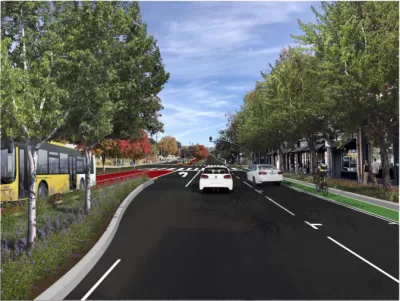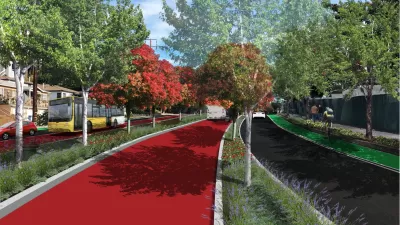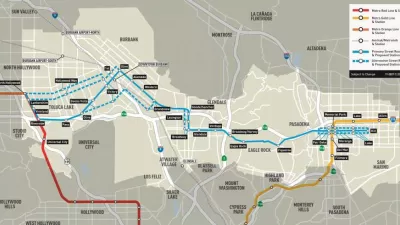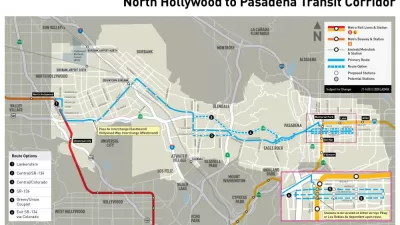A recently appointed councilmember threw a wrench into hard fought local negotiations over a planned bus rapid transit that passes through the Los Angeles neighborhood of Eagle Rock.

The Los Angeles Editorial Board has picked a side in the ongoing controversy regarding a planned bus rapid transit (BRT) route that would connect the Los Angeles neighborhood of North Hollywood to the city of Pasadena, passing through the city of Glendale and the Los Angeles neighborhood of Eagle Rock along the way.
From the earliest conceptions of the planned BRT route, the local residents in Eagle Rock have pushed back on a potential route alignment that would create a bus only lane in the center median of the neighborhood's main drag of Colorado Boulevard. Some local residents advocated hard for the alignment to run down the center of nearby State Route 134.
According to the Editorial Board, compromises included in project's draft environmental impact report (EIR), published last fall, caused disappointment among transit advocates. To avoid taking a traffic lane for the creation of the bus lane, the Los Angeles County Metropolitan Transportation Authority (Metro) proposed the removal of elements like landscaped medians, curbside parking, and bike lanes—elements that could be used to slow car traffic and support businesses along the corridor.
Disappointment with the EIR inspired a group of residents to create the Beautiful Boulevard plan as a response. Metro included some of those recommendations in a new route option proposed to the Metro Board of Directors this month, and that's where the newest round of controversy begins.
As reported by Joe Linton, newly appointed City Councilmember Kevin de León (appointed to replace Jose Huizar, who has been charged of federal corruption crimes) put out a statement supporting the previous alignment, which would maintain the current number of automobile lanes on Colorado Boulevard.
"Last week, the council member released a statement asking Metro to come up with another option that maintained two lanes of traffic in each direction and bike lanes, while attempting to restore medians and curb extensions," according to the editorial. "He also called for more in-person public hearings before Metro chose an option for Colorado Boulevard."
The editorial board calls out Councilmember de León's opposition as another example of politicians unable to walk the walk when it comes to climate action. "There’s a long history of L.A. leaders proclaiming their climate leadership only to abandon climate-minded street design at the first cries of opposition." A lot of people not in Los Angeles have probably seen similar behavior from politicians in their cities too.
Since de León shook up the transit planning debate in Los Angeles and inspired the Los Angeles Times editorial board's criticisms, the Metro board Planning and Programming Committee took a small step forward with the latest version of the plan anyway.
"The committee approved overall project refinements (staff report, presentation), but did not finalize which alternative would take the project through Eagle Rock. The committee action still needs to be approved by the full Metro board next week," reports Linton in a separate, follow up article. The forthcoming decision on the EIR is expected to settle the matter of the lane configuration of Colorado Boulevard, explains Linton in the most recent article.
FULL STORY: Editorial: Why is Kevin de León trying to stall a transit- and climate-friendly project in Eagle Rock?

Planetizen Federal Action Tracker
A weekly monitor of how Trump’s orders and actions are impacting planners and planning in America.

Restaurant Patios Were a Pandemic Win — Why Were They so Hard to Keep?
Social distancing requirements and changes in travel patterns prompted cities to pilot new uses for street and sidewalk space. Then it got complicated.

Map: Where Senate Republicans Want to Sell Your Public Lands
For public land advocates, the Senate Republicans’ proposal to sell millions of acres of public land in the West is “the biggest fight of their careers.”

Maui's Vacation Rental Debate Turns Ugly
Verbal attacks, misinformation campaigns and fistfights plague a high-stakes debate to convert thousands of vacation rentals into long-term housing.

San Francisco Suspends Traffic Calming Amidst Record Deaths
Citing “a challenging fiscal landscape,” the city will cease the program on the heels of 42 traffic deaths, including 24 pedestrians.

California Homeless Arrests, Citations Spike After Ruling
An investigation reveals that anti-homeless actions increased up to 500% after Grants Pass v. Johnson — even in cities claiming no policy change.
Urban Design for Planners 1: Software Tools
This six-course series explores essential urban design concepts using open source software and equips planners with the tools they need to participate fully in the urban design process.
Planning for Universal Design
Learn the tools for implementing Universal Design in planning regulations.
Heyer Gruel & Associates PA
JM Goldson LLC
Custer County Colorado
City of Camden Redevelopment Agency
City of Astoria
Transportation Research & Education Center (TREC) at Portland State University
Camden Redevelopment Agency
City of Claremont
Municipality of Princeton (NJ)





























